Doctor Ronald Beckett is a pioneer in using minimally invasive imaging techniques, particularly endoscopy (examining the inside of the body with a lighted instrument), for the scientific study of mummies. He and his colleague, Jerry Conlogue, were also the hosts of a National Geographic reality television series The Mummy Road Show. Despite the sensationalistic title, the show gave Beckett and Conlogue the ability to conduct a range of studies on mummies around the world and opened many research avenues. Now an emeritus professor from Quinnipiac University, Beckett resides in his native Arizona and continues to teach online courses, including one he developed on Mummy Science. He spoke with us about how he came to the profession of mummy science and the landmark research he has done on mummy conservation with the Anga people of Papua New Guinea.
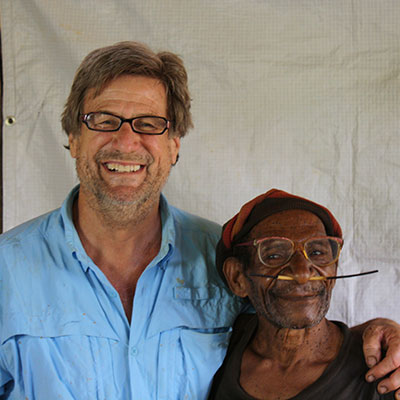
How can mummy studies contribute to public engagement with science?
Ronald Beckett: Presenting on mummies helps plant the seeds of science and math in the minds of school children as well as adults because the mummy can be a vehicle to take learning in many directions. Mummies draw you in, then you can talk about politics, geography, the environment, science, culture, and sociology. Mummies become our teachers; they are time travelers.
You teach a Mummy Science course. That must be more than a history of mummification across the globe.
Absolutely. I start with information about where the word “mummy” came from and discuss the history and development of paleopathology, the study of ancient diseases. Then I talk about the scientific fields involved in studying mummies. Students actually make a mummy out of fruit or chicken. One student mummified a squirrel that he found as fresh road kill! We also teach case studies, and get into bioanthropological information: age at time of death, sex, disease, trauma, and the bioarchaeological aspects of mummy science.
How did you come to mummy studies professionally?
When I first went to university, I was a music major. I left after a year and played music around the world and, when I got back, I got interested in the health sciences. My hobbies were mountain climbing and rappelling. I was on a search and rescue team and worked in hospitals. I then became a respiratory therapist and a respiratory therapy professor.
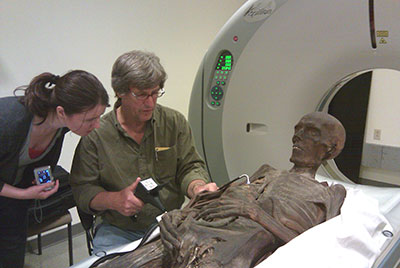
When Jerry Conlogue (Professor of Diagnostic Imaging at Quinnipiac University) and I started working together, he planned to examine a mummy, actually one of the mummies at the Penn Museum. Since an x-ray is flat, two-dimensional, I said, “Well, if we can find an opening in the mummy, we can give the x-ray shadows contour, color, and shape using an endoscope.” Until then, scientists were following the medical model for endoscopy: they would bring the mummy to the hospital or the imaging facility and then conduct a focused biopsy. In 1994, we turned things around and adopted the archaeological model, stripped down our equipment, miniaturized things, and worked in the field. We used the endoscope as much as we could, wherever there was access, as more of a survey tool. Over time we established procedures for examining the interior of the crania and other body cavities, collecting images of the features that would be important to look at from a bioarchaeological perspective. Keep in mind this examination might be inside a mummy bundle, inside the skull; we don’t have to disrupt the individual if there is already an opening allowing for endoscopic access. We can look in the thoracic cavity, down to the pelvic cavity, to see if there is an artifact inside the body or inside the wrappings.
In 1997, we started presenting papers. No one had offered paleoimaging services in the field, so Jerry and I got a lot of invitations from researchers all over the world. In fact, when we were hooked up with National Geographic’s Mummy Road Show in 2000, a lot of doors opened for us. We have subsequently been able to examine probably the greatest variety of mummies of any research team. For someone with a medical background like me, being around mummies was natural. And because of our clinical experience, we also respected different cultures the same way we would respect a patient and their family in a hospital. I think that by using the “house call” approach to paleoimaging in anthropology, we found a niche that needed to be filled.
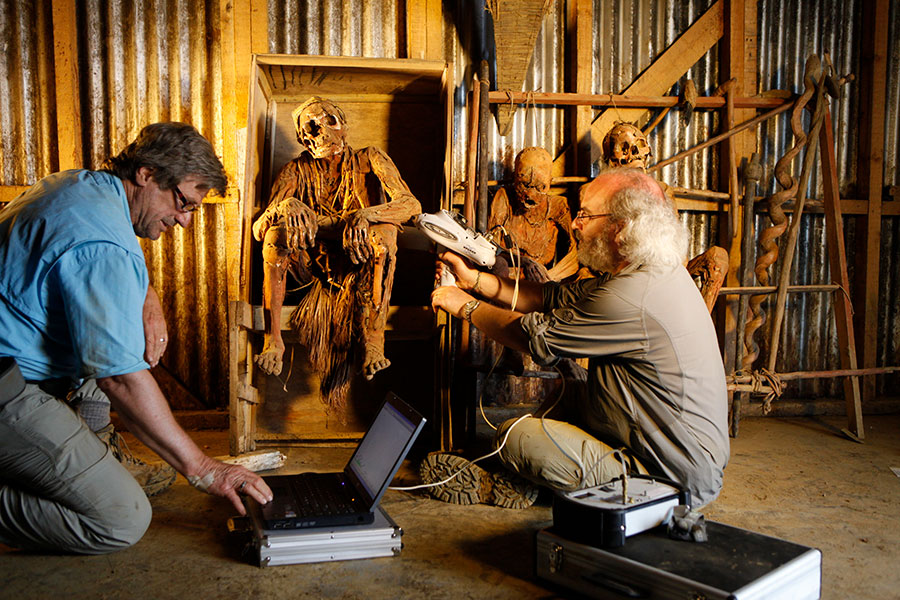
You have been a pioneer in the field of paleoimaging. However, you have also listed Arthur Aufderheide as one of your heroes and he was a proponent of mummy autopsies. From your perspective, do you feel that today’s nondestructive imaging techniques are more than adequate for us to learn what we need to?
I think more and more paleopathologists are becoming satisfied with imaging interpretations, often followed by an as-small-as-possible sample for histology or ancient DNA. With imaging technology, we’re much better able to pinpoint those targets in the body that may represent disease and obtain a small sample. For example, a kidney stone: we can localize that and grab it, and we don’t have to dissect the body. There are some unique cases where it might be worth opening the chest or taking larger samples.
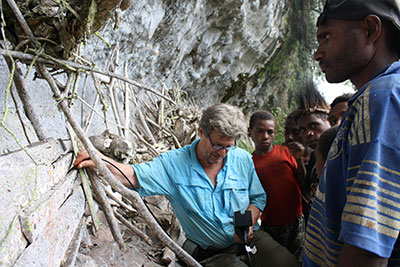
Basically it’s a case-by-case decision rather than a unilateral all or nothing?
Exactly. One of our mantras is to let the data lead the research, let the data generate the questions. Is it even worth moving a mummy from a field site to an advanced CT scanner? It’s not always necessary and it’s so popular now to say, “let’s CT scan everything.” That’s great, but what value are you adding to the study if you can determine answers to many of the basic questions within the context, in the field?
How does your expertise as a scientist, as well as an anthropologist, contribute to your cultural heritage work with living cultures?
When we go into a culture, if we do “pure anthropology” and sit there and take notes, we are impacting the culture and they are impacting us. We’re growing, we’re changing, we’re learning. The Anga culture of Papua New Guinea, for example, are curious and learning and changing, too, as a result of our mutual interactions. In “engaged anthropology,” which we practice, we learn as much from one another as we can. For example, when we go to a Buddhist Temple in Thailand and we observe a self-mummified Buddhist monk, we ask, “How do they do that?” Well, they practice meditation, so we learn about meditation. In Peru, there are cleansing ceremonies where locals burn llama fetuses and coca tea and chew coca leaves. They burn offerings to let the ancestors know that we are friendly. We embrace that kind of experience. In the Philippines, in the Kabayan Jungle there were three pig sacrifices: the livers were read by the shaman before we could even go look at the mummies. So these rituals enrich us. We are not the kind of scientists who impose our science without consideration for the local culture and their history. We try to stay very engaged with people as we obtain the images or sample. It’s a getting-to-know-people job. It’s being human. It’s mutual respect.
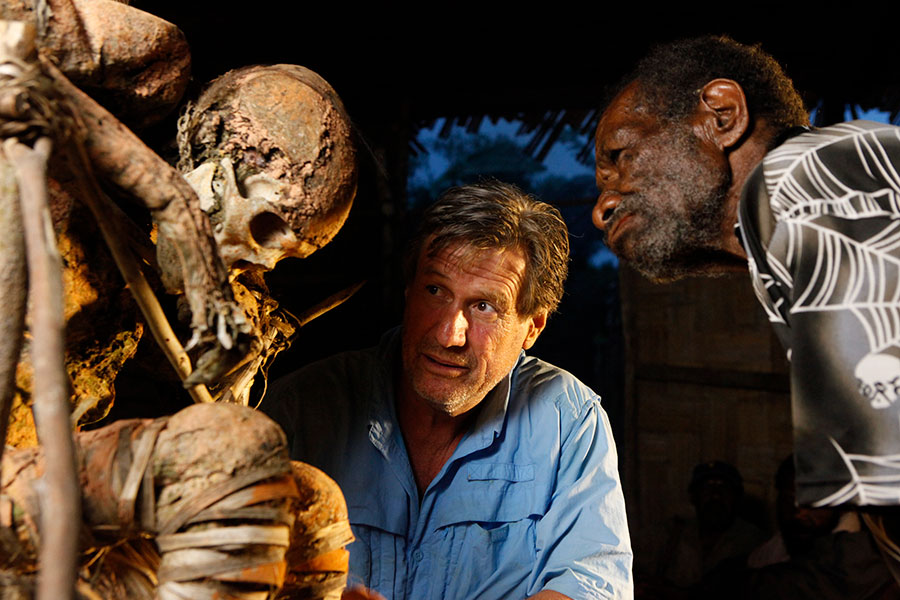
In Papua New Guinea, you’re working with the Anga people on the preservation of ancestor mummies. How did you get involved?
Back in 2004, I was at the mummy congress in Torino when I was approached by a photojournalist who was doing stories on mummy scientists. She wasn’t a mummy scientist herself, but had been to Papua New Guinea several times and was a good ethnographer. She told me of the Anga, and particularly of Gemtasu, a clan leader, and his desire to rekindle the practice of smoked body mummification.
The rainforests of the region are not conducive to body preservation. When a body is to be mummified, a special hut is built to impede the impact of the damp rainy environment. Inside the hut, the deceased is suspended next to and then over a smoky fire that is tended by the relatives of the deceased for more than 30–45 days. The smoke and heat generated in the smoking hut creates a hostile environment for the organisms required for decomposition while also enhancing dehydration and encouraging mummification.
In order to reintroduce this practice, Gemtasu needed to teach mummification to his kids and other villagers, and to restore the deteriorated mummy of his father, Moimango, so that people can see this process and see that smoked body mummification is important to the culture. I thought this would be a phenomenal opportunity: to understand the smoked body process, see the state of preservation of the mummies, and come up with ideas on conserving the bodies.
Part of my initial plan was to take traditional museum materials for the restoration work on the mummies, but I realized that there would be no way for the Anga to acquire these tools and materials if they needed to do restoration touch ups after I left. So I decided that we should go with nothing, I would assess the mummies and see what the needs were, and ask what they could get from their own environment that would function as a glue, that would function as a mesh, whatever it was that we needed. We respected their knowledge of their environment. We didn’t proclaim, “Here is a surgical glue that we are going to use to reattach the skin.”
We collaborated with them and it couldn’t have worked out better. We worked on Moimango and went up the cliffs and worked on several other mummies with villagers, elders, and youngsters. There was a real enthusiasm for reintroducing the smoked body tradition, which is of great importance to the villagers today. We are fixing these bodies and it wasn’t just so Gemtasu could mummify himself. The bodies also relate to territory claims. If you’ve got your ancestors up there on the cliffs it establishes the notion that “we’ve been here a long time.” But if those ancestors deteriorate, you can’t make that claim anymore and in Papua New Guinea, there is still the real potential of losing your territory to a nearby group through a hostile takeover.
In 2015, when Gemtasu died, he was mummified like his ancestors as he had wished. He now sits with his father on a cliff above the village. Other clans in the area continue the tradition of smoked body mummification.
Page Selinsky, Ph.D. is Editor, Penn Museum Publications and Consulting Scholar, Physical Anthropology Section. Paul Mitchell is a Ph.D. candidate, Department of Anthropology, University of Pennsylvania. Page and Paul are guest editors of this special issue of Expedition.
The Penn Museum in Papua New Guinea
Ward Goodenough, born in 1919, was an influential anthropologist and Penn Museum Curator of Oceania Ethnology. In 1951, two years after arriving in Philadelphia, Goodenough was asked to conduct an ethnographic reconnaissance mission to Papua New Guinea. The goal of the expedition was to seek out new areas for further study and collection. Goodenough’s notebooks record careful descriptions of the diverse societies he encountered. In one, he discusses the mummification practices of the Naneuri people.
Goodenough learned the details of the eight-month-long smoking process from his interpreters, viewed, and photographed some mummies. While the Naneuri practice is similar to that of the Anga, others followed different rituals. Goodenough described one tribe that set fire to the house of the deceased, cremating his body inside and retaining only the thighbone. Concerning the beliefs of the Mae people, he wrote: “Death is the result of killing at the hands of another or killing by the ghost of a relative who has already died.” One informant told him: “My grandfather killed my father, my father will kill me, and I will kill my child.”
–Kristen Pearson, Assistant Editor
